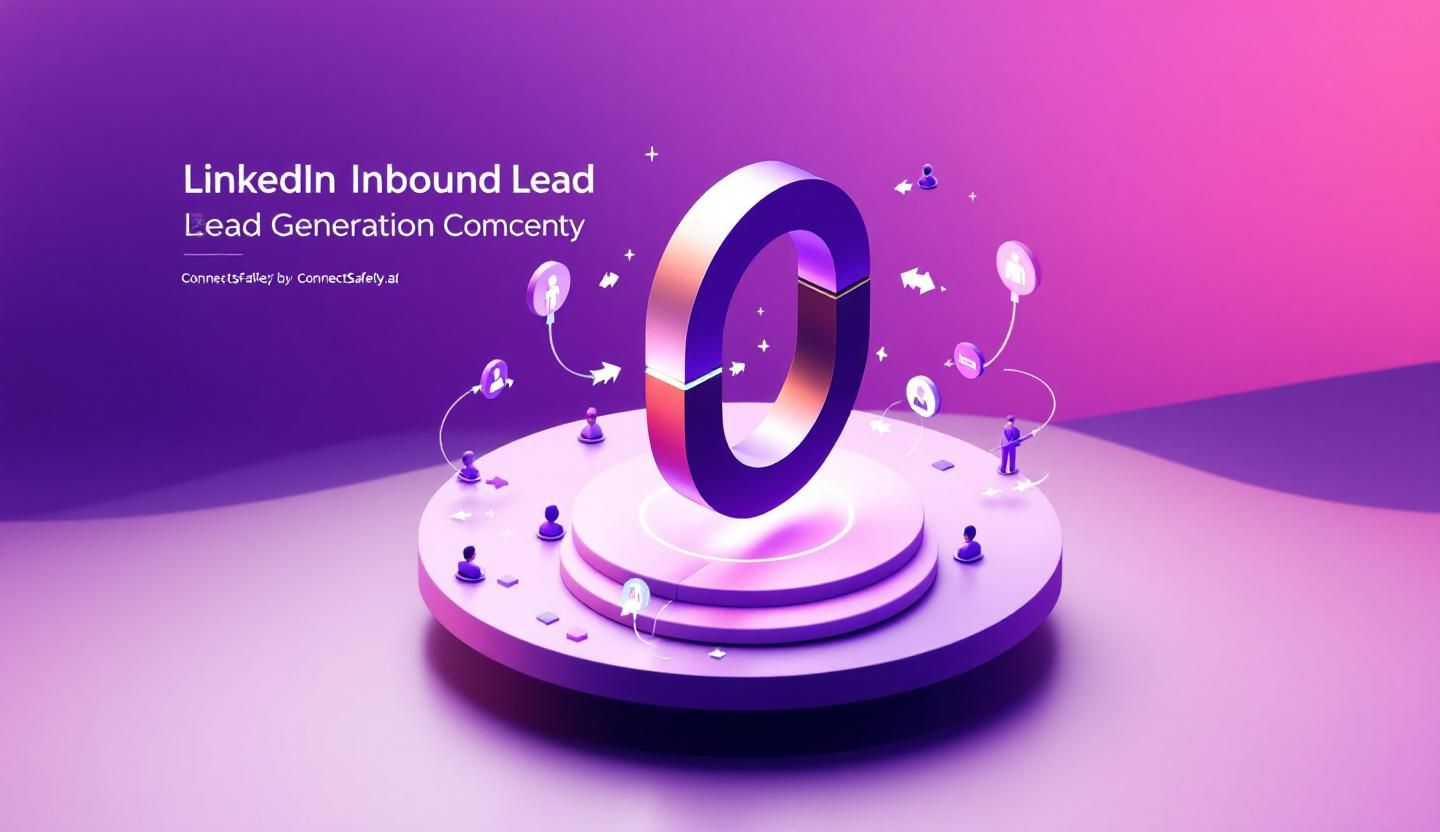Why Platform-Compliant Inbound Beats Automation Detection Worries
Stop worrying about LinkedIn detecting your tools. Build an inbound strategy that's not just undetectable—it's exactly what LinkedIn wants.

If you've researched LinkedIn automation, you've probably fallen down the rabbit hole of "how to avoid detection." Usage patterns. IP address monitoring. Browser fingerprinting. JavaScript analysis. Honeypots. The list goes on.
Here's the uncomfortable truth: if you're worried about LinkedIn detecting your tools, you're playing the wrong game.
The automation arms race—constantly trying to outsmart LinkedIn's detection systems—is exhausting, risky, and ultimately unsustainable. Meanwhile, there's a completely different approach that eliminates detection worries entirely: building LinkedIn presence through platform-compliant inbound engagement.
This isn't about finding better ways to hide. It's about doing what LinkedIn actively wants and rewards—positioning yourself as a valuable contributor who attracts opportunities instead of chasing them.
How LinkedIn Detects Automation (And Why It Matters Less Than You Think)
LinkedIn invests heavily in identifying and restricting automation tools. Understanding their detection methods reveals why trying to outsmart them is a losing strategy:
Usage Patterns: The Telltale Activity Signatures
LinkedIn monitors user activity for patterns inconsistent with human behavior:
- Sudden spikes in connection requests or profile views
- Actions performed at precisely regular intervals (every 60 seconds, exactly)
- Identical timing between activities (comment posted, wait 120 seconds, next comment)
- Volume exceeding what humans realistically accomplish manually
The automation workaround: Randomize action timing, add delays, control pacing to simulate "human-like" behavior.
The inbound reality: When you're engaged in genuine conversations where your expertise is valuable, your patterns ARE naturally human because you're actually providing value, not executing a script.
IP Address Monitoring: Tracking Your Digital Fingerprints
Unusual IP activity triggers LinkedIn's security systems:
- Rapid changes in IP addresses
- Multiple accounts originating from the same IP (data centers, VPNs)
- Geographic inconsistencies (IP in country A, profile claims country B)
- Known data center or proxy IPs
The automation workaround: Use residential proxies, rotate IPs strategically, maintain consistent geographic signals.
The inbound reality: You're logging in from your actual location using your actual device—zero suspicious IP patterns because there's nothing suspicious happening.
Browser Fingerprinting: Identifying What You're Really Using
LinkedIn identifies unique characteristics of your browser and device:
- Browser type and version
- Operating system
- Screen resolution and color depth
- Installed fonts and plugins
- Canvas fingerprinting (rendering signatures unique to each system)
Automation tools often use headless browsers or spoofed user agents that create detectable anomalies.
The automation workaround: Use real browser instances, carefully mimic legitimate configurations, avoid headless browser signatures.
The inbound reality: You're using your regular browser for actual professional networking—the fingerprint matches because it IS you, engaging authentically.
JavaScript Analysis: Detecting Automated Interactions
LinkedIn's website uses sophisticated JavaScript tracking to identify automated scripts and browser extensions:
- Mouse movement patterns (or lack thereof)
- Keyboard input timing and characteristics
- Click patterns and scroll behavior
- Event timing that's too fast or too consistent
The automation workaround: Simulate mouse movements, add random scroll events, vary interaction timing.
The inbound reality: Your mouse movements and click patterns are genuinely human because a human (you) is genuinely engaging with content that matters to your expertise.
Honeypots: The Automation Traps
LinkedIn may deploy fake profiles or content designed specifically to catch automation tools:
- Profiles that only bots would interact with (hidden from normal users)
- Content structured to trap automated scraping
- Engagement opportunities that flag bot behavior
The automation workaround: Try to identify and avoid honeypots—a nearly impossible task since they're intentionally invisible to normal users.
The inbound reality: You're engaging with real people in real conversations about topics relevant to your industry—honeypots are irrelevant because you're targeting humans, not executing blind scripts.
User Reporting: When Your Targets Flag You
LinkedIn relies on users reporting suspected automation:
- Generic, templated messages that scream "bot"
- Obvious copy-paste connection requests
- Irrelevant outreach indicating no personalization
- Spammy follow-up sequences
The automation workaround: Hyper-personalize messages, use AI to generate unique content, make automation invisible.
The inbound reality: When people reach out to YOU because they've seen your thoughtful comments and expertise, nobody reports anything—they're grateful you're visible in their field.
The Fundamental Problem With "Smarter Automation"
Notice the pattern? Every detection method has a potential workaround. Sophisticated automation tools work constantly to stay ahead of LinkedIn's security systems.
But this creates three critical problems:
1. The Arms Race Never Ends
LinkedIn improves detection → automation tools develop workarounds → LinkedIn improves detection again. You're perpetually vulnerable to the next security update.
Real-world impact: Tools that worked perfectly for months suddenly trigger restrictions after a LinkedIn platform update. Your entire lead generation system breaks overnight.
2. You're Always Operating Against Platform Intent
LinkedIn's Terms of Service explicitly prohibit automation. Every "undetectable" tool is still violating platform rules—you're just hoping not to get caught.
Real-world impact: Even if you avoid technical detection, you're building your business on a foundation that LinkedIn actively opposes and can eliminate at any time.
3. The More Sophisticated the Evasion, the Bigger the Risk
Tools that promise to be "completely undetectable" often employ the most aggressive evasion techniques—rotating IPs, spoofing browsers, manipulating requests. When these ARE detected (and eventually they will be), the consequences are severe because the intent to deceive is obvious.
Real-world impact: Account bans, reputation damage, and loss of your entire LinkedIn network—often with no warning and no recourse.
The Inbound Alternative: Working WITH LinkedIn, Not Against It
Here's the paradigm shift: what if you stopped trying to avoid detection and started doing things LinkedIn actively wants more of?

LinkedIn's 2024-2025 algorithm changes explicitly favor:
- Knowledge-rich content that demonstrates expertise
- Thoughtful engagement via comments that add value
- Relationship-building over transaction-seeking
- Authority positioning backed by consistent visibility
This isn't speculation—LinkedIn publicly stated these priorities. The platform wants to surface expertise and facilitate meaningful professional connections.
Inbound lead generation aligns perfectly with LinkedIn's goals. When you:
- Engage thoughtfully in industry conversations
- Demonstrate expertise through valuable insights
- Build visibility in front of your ideal clients
- Attract inbound inquiries from interested prospects
...you're doing EXACTLY what LinkedIn wants to enable. There's nothing to detect because there's nothing LinkedIn opposes.
Why Platform-Compliant Inbound Eliminates Detection Concerns
Let's map inbound strategies against every detection method:
Usage Patterns: Your activity reflects genuine human engagement with content you care about. Variable timing because real conversations don't follow schedules.
IP Address Monitoring: You're accessing from your actual location and device. No proxies, no VPNs, no suspicious patterns.
Browser Fingerprinting: Your actual browser on your actual computer. Perfect fingerprint match because there's no deception.
JavaScript Analysis: Real mouse movements, natural scrolling, authentic interaction patterns because you're actually reading and engaging.
Honeypots: Irrelevant. You're targeting real people in your industry having real conversations—you'd never interact with a honeypot because it wouldn't be part of meaningful professional discourse.
User Reporting: Not only are reports unlikely, but you're building positive reputation. People WANT to connect with the person adding valuable insights to their content.
The result: Zero detection risk because you're not doing anything LinkedIn opposes. You're a power user, not a rule-breaker.
The Business Outcomes: Compliance That Outperforms Evasion
Beyond eliminating risk, platform-compliant inbound strategies deliver better business results:
Higher Quality Engagement
Automation approach: Reach thousands, get low response rates, field skeptical conversations.
Inbound approach: Attract dozens of interested prospects, convert at 14.6% vs. automation's 1.7%—an 8-9X improvement.
When prospects come to you because they've seen your expertise, conversations start from trust instead of skepticism.
Sustainable Competitive Advantage
Automation approach: Any competitor can buy the same tool and blast the same messages. It's commoditized.
Inbound approach: Building recognized expertise and authority creates differentiation competitors can't easily copy. Your reputation compounds over time.
Aligned With Platform Evolution
LinkedIn's changes increasingly penalize volume-based outbound tactics:
- Connection requests reduced from 100/day to 100/week (80% reduction)
- Algorithm prioritizes expertise signals and meaningful engagement
- Comments now boost reach 15X more than passive likes
Automation approach: Fighting against platform direction, getting less effective over time.
Inbound approach: Capitalizing on platform changes that make your strategy MORE effective over time.
Zero Platform Risk
Automation approach: Constant vulnerability to detection improvements, account restrictions, permanent bans.
Inbound approach: Zero risk because you're operating within platform guidelines doing what LinkedIn actively encourages.
Your LinkedIn presence becomes an appreciating asset instead of a liability you're constantly protecting.
How to Implement Platform-Compliant Inbound Lead Generation

Here's how to transition from detection-worried automation to confident inbound strategies:
Step 1: Reframe Your Objective
Old goal: Reach as many prospects as possible without getting detected.
New goal: Position yourself where your ideal clients already pay attention, so they discover you naturally.
This shift eliminates detection concerns because your activities align with platform intent.
Step 2: Identify Strategic Conversations
Instead of scraping profiles to build cold outreach lists, identify where meaningful conversations happen:
- Which thought leaders do your ideal clients follow?
- What topics generate engagement in your industry?
- Where are decision-makers seeking advice and perspectives?
Your targeting becomes conversation-based rather than profile-based.
Step 3: Engage With Genuine Expertise
Add value to high-impact conversations:
- Share unique frameworks or perspectives
- Provide specific, actionable insights
- Ask questions that deepen discussion
- Reference data or experience that demonstrates credibility
Critical difference: You're not executing a script—you're genuinely participating in professional discourse. LinkedIn sees expert engagement, not bot activity.
Step 4: Make It Efficient (Not Automated)
The challenge: genuine engagement takes time. The solution: smart amplification tools that maintain authenticity.
What to look for:
- AI that helps craft personalized comments in your voice
- Targeting that identifies highest-value conversations
- Tracking that proves inbound lead generation ROI
- 100% platform-compliant activities LinkedIn encourages
What to avoid:
- Anything that automates connection requests or messages
- Tools that operate against LinkedIn's Terms of Service
- Volume-based tactics that prioritize reach over relevance
Step 5: Track Inbound Results, Not Evasion Success
Old metrics: "We sent 500 messages without getting flagged!"
New metrics:
- Profile views from ideal customer personas
- Inbound connection requests from target audience
- Qualified conversations initiated by prospects
- Actual business opportunities generated
Success is measured by attraction, not by successfully hiding.
How ConnectSafely.ai Enables Platform-Compliant Inbound
ConnectSafely.ai was built specifically for this approach—making platform-compliant engagement efficient without crossing into prohibited automation:
Core Differentiators:
1. Engagement-Focused, Not Outreach-Focused: The platform identifies valuable conversations where your expertise matters—no connection spam, no bulk messaging, no Terms of Service violations.
2. AI-Powered Authentic Participation: Generate thoughtful comments that sound like you because they're based on your expertise and voice—not generic templates LinkedIn immediately recognizes.
3. Zero Detection Risk: 100% platform-compliant activities focused on engagement, value-sharing, and relationship-building. Nothing to detect because nothing violates platform guidelines.
4. Inbound Lead Tracking: Monitor the metrics that matter—profile views, connection requests from ideal clients, inbound DMs—proving ROI through attraction, not interruption.
Results for users:
- Maintain active LinkedIn presence in 30 minutes per week
- Generate 10-20 qualified inbound leads per month
- Build authority that compounds over time
- Zero platform risk or account restrictions
At $39/month (96% less than traditional automation tools), ConnectSafely.ai delivers 10-32X better ROI through conversion rates of 14.6% instead of 1.7%—all while staying completely aligned with LinkedIn's platform guidelines.
Why Worrying About Detection Means You're Playing the Wrong Game
The fundamental question isn't "How can I avoid LinkedIn's detection systems?"
The fundamental question is "How can I position myself so my ideal clients discover me and want to connect?"
Detection worries evaporate when you're operating within platform guidelines doing activities LinkedIn actively rewards with increased reach and visibility.
The paradigm shift:
- Automation mindset: "How do I scale outreach without getting caught?"
- Inbound mindset: "How do I build expertise visibility that attracts opportunities?"
One is perpetually vulnerable to platform changes. The other benefits FROM platform changes that increasingly favor authentic expertise and engagement.
Key Takeaways
- Detection evasion is an unwinnable arms race: Every workaround is temporary until LinkedIn's next security improvement makes it obsolete
- Platform-compliant inbound eliminates detection concerns: You're doing what LinkedIn wants and rewards—nothing to detect because nothing violates guidelines
- Better business results without the risk: Inbound leads convert at 14.6% vs. automation's 1.7% while carrying zero account restriction risk
- Sustainable competitive advantage: Building authority creates differentiation that compounds over time instead of commoditized tool access
- Aligned with LinkedIn's evolution: Platform changes increasingly favor expertise and engagement—making inbound MORE effective over time
The future of LinkedIn lead generation belongs to professionals who stop fighting the platform and start working with it—building magnetic presence that attracts ideal clients instead of deploying increasingly sophisticated evasion techniques.
Ready to stop worrying about detection and start attracting inbound leads? Start with ConnectSafely.ai and experience platform-compliant engagement that LinkedIn rewards instead of penalizes.
Stop hiding. Start attracting.
